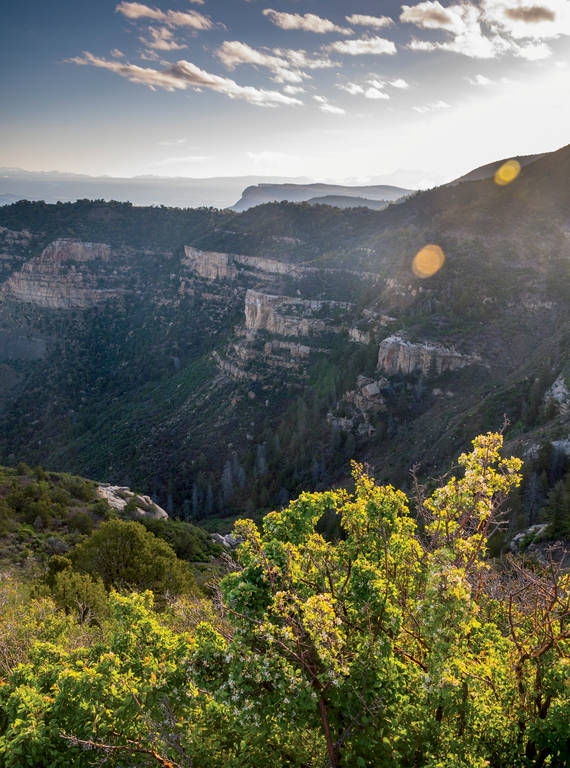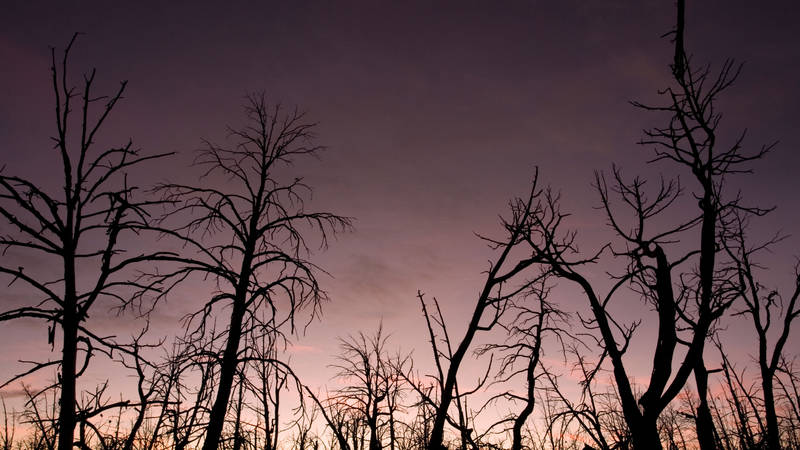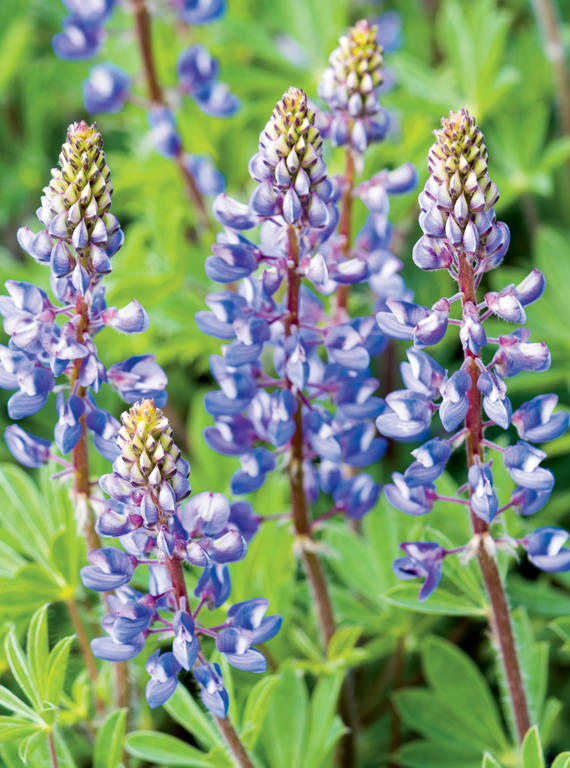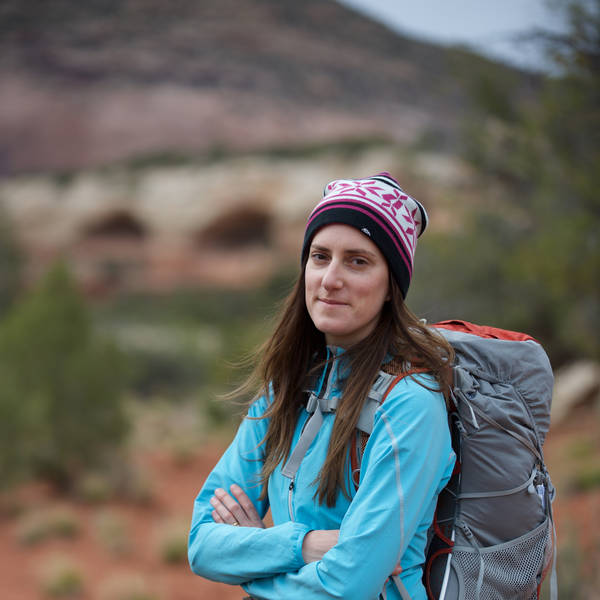Fall 2017
An Uncertain Future
As climate change shapes the Southwest, Mesa Verde National Park strives to protect both ancient forests and vulnerable cliff dwellings.
Hooked onto a rope slung around a tree, National Park Service rock climber Dave Mealey walked backward off a cliff above Spruce Tree House, one of the best-preserved Ancestral Puebloan cliff dwellings in Mesa Verde National Park. About 10 feet below the rim, he peered into a hole with a bolt inside, evidence of a 1960s-era attempt to staple the crumbling bedrock together. He joggled the rod, picked up a piece of grout that came loose, tossed it up to his partner, Derek Beitner, and snapped a few photos. Across the canyon, crowds of visitors gaped with their cameras and phones aloft.
A specialized Park Service climbing team, the duo worked quickly, keeping an eye on the sky. That morning, a Tuesday in May, was unseasonably cold and stormy. Hours before, hail had pelted the pinyon-juniper woodlands, plonking loudly on car roofs and coating roads in a two-inch-thick layer of slippery white balls. “The weather has been really weird this year — the last few years, actually,” said Tim Hovezak, program manager for preservation archaeology at the Colorado park.
Hovezak, along with Park Service geotechnical engineer James Mason, had called in the climbers to inspect the bolts and the sandstone cliff. What they found would help Mason, Hovezak and other park staff determine what needed to be done to stabilize the rock. Spruce Tree House has been closed to visitors since late 2015 because of dangerous rockfall, which threatens both the ruins and visitors. After much study, park staff deliberated over solutions this summer: Bolt the rock together again? Set up a metal mesh net to catch flying rocks? Or aggressively clean the cliff of loose rock annually, the way a dentist scratches off plaque and tartar?
The same erosion that carved the sweeping alcoves in these sandstone cliffs will eventually lead to their demise, but staff believe that climate change may be hastening the disintegration. In particular, they blame freeze-thaw cycles, in which water seeps deep into the stone, then freezes and expands, wedging the rock apart. After the ice melts, water sinks deeper into the rock and repeats the cycle. As climate change brings wilder weather, temperatures swing above and below freezing more frequently. Anecdotally, Tim Hovezak, who leads a team of Park Service stonemasons who fix and care for the ruins, reports seeing significantly more rockfall in recent years, though it’s difficult to collect data to show that.
In general, without a control group, it can be challenging to pinpoint exactly which phenomena, from crumbling cliffs to displaced species, are the result of global warming. “You can’t run parallel universes and say, ‘OK, here you don’t have climate change and here you do.’ You can theorize it’s happening here, but you can’t prove it,” said George San Miguel, natural resource manager at Mesa Verde. “The question is, how much intervention should we do?”
The next day, under a partly cloudy sky, Mealey and Beitner tied ropes around trees above Cliff Palace, a magnificent stone village with 150 rooms and 23 ceremonial chambers known as kivas. Directed by Mason, who radioed to them from the opposite cliff, they took turns rappelling down. Their mission was to clear off rocks and sand that had loosened from the cliff and trundle them down so that the park could open the site to visitors after a seasonal closure. Hovezak’s team had built scaffolding to protect the ruins, and the stones clattered on the plywood below. A small crowd gathered on the canyon edge to watch the men dangle.
With a small hammer, Mealey tapped the rock to release fist-sized stones. Plink plink plink. Suddenly, to his surprise, an 800-pound trunk-shaped boulder broke loose. The audience gasped as it barreled down, smashing through the plywood and landing on the sandy floor of a ruin with a great boom that ruptured the silence of the canyon and echoed off the cliffs.
The effects of climate change on landscapes and wildlife in national parks are well documented. Glaciers are vanishing. Bird migration routes are changing. Precipitation patterns are shifting. But what about the archaeological and cultural resources the parks also protect?
“You don’t hear very much about the cultural resources threat from climate change,” said Vanessa Mazal, Colorado program manager for NPCA. “You think about the effect on natural resources, but the fact that there can be this amount of exposure that’s degrading an ancient resource, that’s surprising and gets people’s attention. It’s like, ‘Oh my God, how can this be?’”

View of the mesa and surrounding plains from the Montezuma Valley Overlook.
© KENNAN HARVEYSea-level rise threatens archaeological remains on shorelines from Alaska to Florida. Along the coast of the Gulf of Mexico, more intense storms are expected to batter historic structures, such as Fort Jefferson in Florida’s Dry Tortugas National Park. In Mesa Verde, the first national park established to protect archaeological treasures, cliff disintegration, wildfire, loss of surface water and the proliferation of invasive species are the biggest climate-related threats to park resources. Despite uncertainty around what the future holds, a diverse team of park staffers is working to safeguard these irreplaceable dwellings and the plant and animal species that have lived here since the time of the ancients.
In southwest Colorado, the signs of climate change are already apparent. The mean average air temperatures have increased by 2 degrees over the last three decades, and bark beetles, which thrive in warmer conditions, have ravaged forests. Between the late 20th century and 2035, temperatures are expected to rise between 2 and 5 degrees. In August, a group of nonprofits, universities and federal agencies released a report that analyzed how changing conditions will affect the area’s pinyon-juniper forests. The researchers predicted that in less than 20 years, summers at lower elevations could last one to three weeks longer, and the risk from wildfires will increase up to twelvefold.
Fire is the most noticeable sign of climate change in Mesa Verde. Although no single fire can be attributed to global warming, scientists correlate the increasing number of wildfires with the changing climate. Mesa Verde has lost about half of its forest cover since 1906, when it was founded, with fires burning 24,000 acres from just 2000 to 2003. (More recently, fewer infernos have raged because detection methods have improved, allowing firefighters to suppress fires quickly, and local conditions have not been quite so dry.) Along the park’s narrow winding roads, wooden signs bear the names and dates of fires in recognition of what happened to these once-lush forests. Fire also has scarred some ancient stone walls, and it caps the soil with a hydrophobic layer, preventing water from seeping in. As a result, water rushes over the land as if it were rock, and that can damage artifacts and exacerbate flash flooding.
“Moving water is one of the worst things for archaeological sites, whether it’s big raindrops or floods coming down a canyon,” said George San Miguel. “Even smaller or lighter burning wildfires are going to be a risk to park resources.” The Park Service considers the pinyon-juniper forests to be cultural treasures. Ancestral Puebloans used the trees for everything from house posts to firewood and depended on the pinyon’s protein-rich, fat-rich nuts for sustenance.
“We want visitors to have the experience of stepping back in time and walking in the footsteps of these ancient people,” said Kristy Sholly, chief of interpretation. “In the future, will you still be able to have that experience of walking through a pinyon-juniper woodland? Will you be able to see what the Ancestral Puebloans used as their grocery store? If not, it isn’t really the same story anymore.”
To reduce the likelihood that lightning strikes will swell into uncontrollable blazes, park staff cut down small shrubs and trees, dubbed “fuel” in firefighting lingo. They thin forests near prime attractions like the cliff dwellings, some of which still feature original log beams and flammable artifacts. “But there’s nothing we can do to radically alter all the vegetation in the park,” said San Miguel. “We don’t have the workers or money to do that.” In the early 2000s, flames licked close to some dwellings identified by a 1990s study as particularly vulnerable to wildfire. Staff were concerned, but after the fires passed, they were relieved to find that the blazes did not damage the sites as expected, perhaps because the ruins were tucked in alcoves where the heat couldn’t reach them.

Mesa Verde has lost about half of its forest cover since 1906, when it was founded, with fires burning 24,000 acres from just 2000 to 2003.
© BOB GIBBONS/ALAMY STOCK PHOTOA sea of blackened trees can appear eerily beautiful, but they also portend deeper changes to plant and animal communities. Pinyons grow slowly and only start reproducing at about 50 or 60 years of age. Even in places where infernos raged decades ago, the forests aren’t regenerating. A 2015 study published in the journal Nature Climate Change suggests that the needleleaf evergreen forests in the Southwest will likely die out by 2100. In Mesa Verde, different casts of birds have moved into burned areas, supplanting forest species like the pinyon jay and gray vireo. And invasive non-native plants are taking root. One rare native plant is particularly susceptible to the changes: the Chapin Mesa milkvetch, a spindly tuft that grows only in the park and adjacent tribal lands.

Lupine plants growing in a section of the park that had been burned in a wildfire.
© KENNAN HARVEYOn another Tuesday in May, I sat cross-legged on the ground in a burnt forest, staring unblinking at the plant, which bloomed with dozens of delicate white trumpet-like flowers. To a casual observer, I might have appeared like a Zen monk or perhaps simply crazy. But this was contemplation in the service of science. Along with several other locals, I volunteered to help Park Service ecologist Tova Spector and Renee Rondeau, an ecologist with the Colorado Natural Heritage Program, perform a study on the plant.
Since 2001, researchers have studied this endemic species at the request of the Park Service and the U.S. Fish and Wildlife Service, which recognizes it as a candidate for the endangered species list. In 2002, a wildfire swept through the study area, offering an unexpected opportunity to intimately observe how fire affects the plant.
At first, the milkvetch seemed to thrive in the burnt forests, outcompeting other plants. But 14 years after the fire, researchers saw that new seedlings were not sprouting. Over time, the plant fares much better in unburned forests and dwindles in burns. But why?
“It’s kind of a detective story, and we’re trying to figure it out,” said Rondeau, as she packed up a bright orange backpack with supplies, including a yardstick, wind gauge and thermometer. Rondeau, a small, hardy, charcoal-haired woman with an outsize enthusiasm for plants, has lots of hypotheses: Perhaps the milkvetch is languishing in burnt areas because the soil is dryer from the direct sunlight or temperatures fluctuate more dramatically without the insulating effect of a forest. Or maybe a non-native grass that has thrived post-burn is to blame, or there are fewer insects in burnt forests and therefore less pollination.
This study was exploring the last idea by comparing the number of pollinators in burnt and old-growth forests. My task: Count the pollinator visits at one randomly selected plant for precisely 10 minutes. After setting a timer, I plopped down and stared at its delicate stalks so I didn’t miss a single buzzing critter. Crickets chirped. Meadowlarks trilled. One drowsy ant crawled into a flower, and a bee zoomed by. No pollinators.
NPCA at Work
“The bane of a biologist … zeros,” said Rondeau, who finished up her count at a different plant and recorded her findings — also zeros — on an iPad. “I hate zeros. It just doesn’t tell you much.” While any given field day might present leads or dead-ends, the multiyear study has already revealed information about this quirky plant that will inform the Fish and Wildlife Service’s decision about whether to list it as threatened or endangered. Still, there are many unknowns — a fact that motivates Rondeau. “It’s cool,” she said, tromping through the field to the next plant, “to have so many mysteries to solve.”
To the average layperson, who may be unaware of the link between the climate and phenomena such as wildfire, the effects of global warming are largely invisible at Mesa Verde. But staff hope to educate visitors and challenge people to think more deeply about the broad changes happening in the park and across the planet.
“Even as a park employee, when I came here a year ago from Alaska, I didn’t expect to see the effects of climate change,” said Sholly. “Visitors are also surprised to hear about it — and that’s why I want to make sure we’re getting the message out.”
Sholly is overseeing the development of two interpretive exhibits about climate change in the park for the visitor center and the museum. Rangers also often incorporate the topic into their tours of the cliff dwellings: Drought caused by climate change, archaeologists theorize, played a role in the mass exodus of the ancients from this area at the end of the 13th century.
“It’s definitely something that we tie in with what’s happening now,” said Sholly. “Even though the changes back then were not human-caused, there are similar effects today — decreased water availability, more fires and changing ecosystems.”

National Parks
You can read this and other stories about history, nature, culture, art, conservation, travel, science and more in National Parks magazine. Your tax-deductible membership donation of $25 or more entitles…
See more ›There is some evidence of violence among the Ancestral Puebloans at the end of their occupation, perhaps because of competition for resources. On a walk through the blackened fingers of burnt trees one afternoon, I contemplated the overwhelming nature of the changes we face now.
Part of the thrill of Mesa Verde National Park is imagining what it must have been like to live in a stone village so many centuries ago and comparing it to our own lives. I stopped at an overlook with views of Long House, a series of elegant towers and rooms perched in an alcove. The residents must have tackled great challenges and faced considerable danger surviving in this dry land. And yet, they built wonders. Their chapter, of course, has ended, and ours is still unfolding. How will we respond to the challenges of our own time?
About the author
-
 Kate Siber Contributor
Kate Siber ContributorKate Siber, a freelance writer and correspondent for Outside magazine, is based in Durango, Colorado. Her writing has appeared in National Geographic Traveler and The New York Times. She is also the author of “National Parks of the U.S.A.,” a best-selling children’s book.



